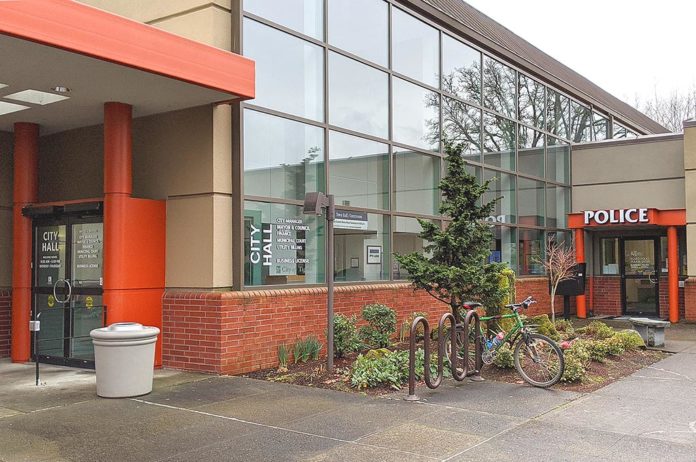The City Council is moving forward with placing a public safety levy on the May ballot, but council members say they will find a way to fund additional police officers and training whether or not the measure passes.
The council on Jan. 14 settled on a levy rate of 29 cents per $1,000 of assessed property value, which would add about $81 to the typical Tigard household’s property tax bill. Previously, levy rates ranging from 46 to 33 cents had been considered; council members hope the lower rate will be more palatable to voters.
“I support the 29 cents, because I think it’s more likely to pass,” Councilor Tom Anderson said Jan. 14. “It’s a political decision rather than a needs-based decision, but we’d like to get something rather than nothing, and we can build on that later.”
Between 2010 and 2018, there was a 27 percent increase in calls that Tigard police officers responded to, according to the city. During that same period, officer staffing decreased by 4 percent.
On Jan. 21, the council finalized ballot language for the measure and voted unanimously to put it before voters in the May 19 election. If passed, the levy would raise about $10.6 million over its five-year lifespan, according to city estimates.
The 29 cent per $1,000 rate – which would come to about 22 cents per day or $6.75 per month for the typical Tigard home – would pay for eight new patrol officers, de-escalation training for all sworn officers, a school resource officer and additional support staff. The assessed value, which differs from market value, of a typical house in the city is $280,040, according to city staff. Currently, property taxes on such a home are about $4,817, with about $800 of that going to Tigard and the remainder going to schools and other jurisdictions.
Previous levy packages included the addition of two new officers trained to work with the city’s homeless population, rather than a school resource officer. During the Jan. 14 discussion, councilors Heidi Lueb and Liz Newton argued in favor of including the homeless outreach officers in lieu of a school resource officer, saying that the former is needed to address local policing trends.
‘I’m a little bit worried about diluting our message again. If our top priorities are to get those officers on the street to address this trending change in how our officers are spending their time, we can use the homeless outreach resource for that,” Newton said. “I feel like there are stories that can be told around those asks. I’m not opposed to the [school resource officer], but I keep going back to our officers and the kinds of calls they’re getting, how they’re spending their time and making sure they’re getting the support they need, the training they need and that we’re fully staffed.”
Mayor Jason Snider said he agreed in principle but thought the addition of the school resource officer would appeal to voters.
“I think it’s much less likely to pass without that,” he said. “I think that’s a political consideration that we’d be foolish to ignore.”
Police Chief Kathy McAlpine told the council that her priority is the new patrol officers and that both the homeless outreach team and the school resource officers are less important.
“That is what I truly need to have to have consistency, to have safety, to have support for the officers to serve the community,” she said. “There are needs in other places. But, at the end of the day, if you’re asking me, the most important thing is the eight officers and the support that goes with that.”
The Tigard Police Department has 85 full-time employees; 69 of those are sworn officers, according to a city staff report. Adding the new patrol officers would increase staffing levels by one officer per shift for a total of four to five officers per shift. McAlpine has said that nearly half of shifts are staffed at minimum levels of three to four officers.
During the Jan. 14 meeting, Lueb and Newton ultimately agreed with the rest of the council to move forward the 29 cent rate that includes eight patrol officers, de-escalation training, a school resource officer and support staff.
“I’m all in, whatever we decide, because we have to address this,” said Newton, who in the past has noted that, rather than increasing services, the council is seeking to keep pace with the volume and types of calls the police are dealing with. “The chief is right, we’re getting close to crisis here.”
Alternative Public Safety
Funding Options:
During recent discussions about the levy and police funding, the council has indicated that, should voters reject the levy, they will seek alternative ways to raise the money.
When talking about potential ballot language on Jan. 14, Snider raised the idea of expressly stating that “the meaning of a ‘no’ vote is that this problem will be solved a different way by the council.”
“I think the council is resolute on solving this problem,” he said. “It may help the gravity of the problem and the seriousness with which the council intends to act and, therefore, may drive slightly different behavior” with voters.
At a Dec. 17 workshop, Snider raised the idea of public safety utility fee, and the council asked city staff to come up with some funding schemes other than a levy.
Staff provided a variety of options during a Jan. 7 council meeting. These included:
- Gross receipts tax on businesses (“a version of a sales tax,” per city staff)
- Food and beverage tax
- Payroll/income tax
- Business license/tax
- Use general funds, such as red light camera revenue
- Cut other programs, such as library, community development and city management programs























